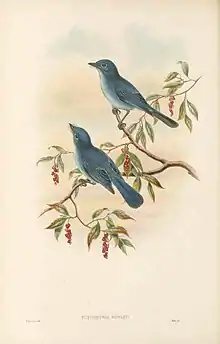Cerulean paradise flycatcher
The cerulean paradise flycatcher (Eutrichomyias rowleyi) is a medium-sized (up to 18 cm long), blue flycatcher with bright cerulean blue plumage, a bare white orbital ring, dark brown iris, bluish black bill and pale blue-grey below. The young has a shorter tail and grey underparts. It is the only member of the monotypic genus Eutrichomyias.
| Cerulean paradise flycatcher | |
|---|---|
 | |
| Cerulean paradise flycatcher by Richard Bowdler Sharpe, 1888 | |
| Scientific classification | |
| Kingdom: | Animalia |
| Phylum: | Chordata |
| Class: | Aves |
| Order: | Passeriformes |
| Family: | Monarchidae |
| Genus: | Eutrichomyias Meise, 1939 |
| Species: | E. rowleyi |
| Binomial name | |
| Eutrichomyias rowleyi (Meyer, 1878) | |
| Synonyms | |
| |
Taxonomy and systematics
The scientific name commemorates the British explorer and ornithologist George Dawson Rowley. The cerulean paradise flycatcher was originally described in the genus Zeocephus. Alternate names include Cerulean flycatcher, Rowley's flycatcher and Rowley's paradise-flycatcher. In 2017 sequencing of DNA from the type specimen found that it was a member of Lamproliidae along with Chaetorhynchus and Lamprolia.[2]
Distribution and habitat
The cerulean paradise flycatcher is endemic to the island of Sangihe, off North Sulawesi in Indonesia. Previously known only from a single specimen collected in 1873, this rare bird was rediscovered in October 1998 around forested valleys of Mount Sahendaruman in southern Sangihe.
Behaviour and ecology
Food and feeding
Its diet consists mainly of insects and other small invertebrates.
Threats
Due to ongoing habitat loss, a small population size, and limited range, the cerulean paradise flycatcher is evaluated as Critically Endangered on the IUCN Red List of Threatened Species.
References
- BirdLife International (2013). "Eutrichomyias rowleyi". IUCN Red List of Threatened Species. 2013. Retrieved 26 November 2013.CS1 maint: ref=harv (link)
- Jønsson, Knud Andreas; Blom, Mozes P.K.; Päckert, Martin; Ericson, Per G.P.; Irestedt, Martin (March 2018). "Relicts of the lost arc: High-throughput sequencing of the Eutrichomyias rowleyi (Aves: Passeriformes) holotype uncovers an ancient biogeographic link between the Philippines and Fiji". Molecular Phylogenetics and Evolution. 120: 28–32. doi:10.1016/j.ympev.2017.11.021. PMID 29199105.
